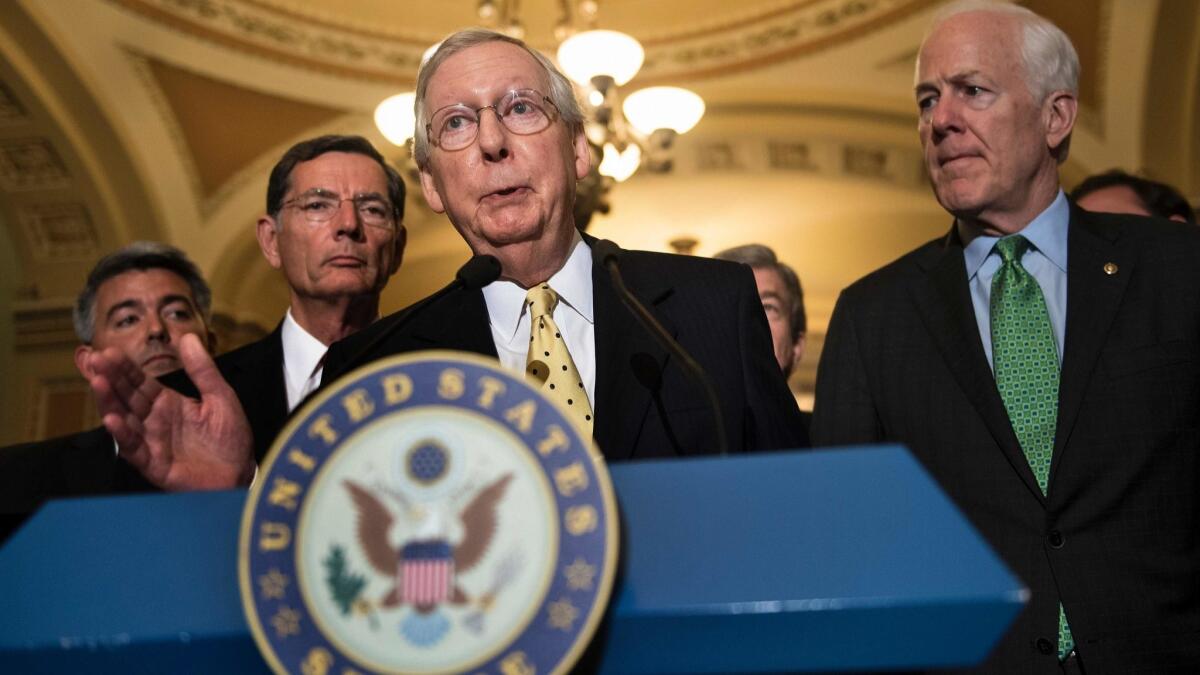Obamacare still lives, but Trump’s rule on HRAs may remake health insurance in U.S.

- Share via
President Trump’s attempt to transform American health insurance is almost complete.
Twenty months ago, frustrated after attempts to repeal Obamacare fell apart in the Republican-controlled Senate, Trump pledged to use executive power to do what Congress failed to legislate. An executive order set in motion regulations to promote “healthcare choice and competition across the United States.”
On Thursday, the administration finished the last of three rules to do just that — advancing conservative policies without undoing the central framework established by the ACA.
Together, the changes have loosened Obama-era restrictions on short-term health plans that don’t meet the ACA’s standards. They’ve permitted small employers to join together to buy lightly regulated coverage called association health plans. And the rule published Thursday gives employers, particularly small businesses, more flexibility to steer tax-exempt dollars to employees for healthcare.
The administrative actions are far short of repealing or replacing the Affordable Care Act, the law that expanded coverage to about 20 million people. Many of the ACA’s elements remain largely intact, including billions of dollars in subsidies, strict standards for insurance plan design, and rules that protect people with preexisting medical conditions.
But Trump’s agencies have “taken administrative steps to shift the health law quite significantly,” said Larry Levitt, senior vice president for health reform at the Kaiser Family Foundation, a health research group.
Spreading risk
The cumulative effect could erode a core principle of the ACA: ensuring that people can rely on their health insurance if they get sick, and to spread the costs of illness widely.
“It opens up an opportunity for healthy people to land with coverage that may be cheaper, but not necessarily as comprehensive,” said Kevin Lucia, research professor at Center on Health Insurance Reforms at Georgetown University.
The rule completed Thursday expands the use of health reimbursement arrangements, or HRAs, which let employers use tax-exempt funds to help workers pay for medical expenses, like a co-pay at a doctor’s office. In the past, HRAs could be used only in combination with group health plans sponsored by the employers. Starting in 2020, companies can use HRAs to subsidize workers buying entire health plans on the individual market, instead of offering them a company plan.
The Trump administration estimates that the rule will have far-reaching effects in the long run. It projects that 800,000 employers, most with fewer than 20 workers, will eventually offer HRAs to help 11 million workers purchase individual insurance coverage by 2029.
That could have a profound impact on the many Americans who now get coverage through their jobs — sending them out to buy their own coverage instead.
“It has the potential to transform employer-provided health insurance in a major way,” Levitt said in an email. If the projections are accurate, that would represent “a huge influx” of workers into the individual market governed by Obamacare rules.
Meaningful change
A broad shift to HRAs could resemble the movement in retirement benefits from defined benefit pensions to 401(k) plans, where employers make fixed contributions instead of promising a set benefit for years in the future. A similar change in health coverage would give businesses more predictable costs, while shifting the risk of higher healthcare expenses onto workers.
“The rule will provide hundreds of thousands of businesses a better way to offer health insurance coverage, and millions of workers and their families a better way to obtain coverage,” Joe Grogan, director of the White House Domestic Policy Council, told reporters on a conference call Thursday.
While it may be years before the full consequences of more flexible HRA rules become clear, other effects of Trump’s executive order are already apparent.
The biggest impact so far comes from the rule expanding access to short-term health plans. While the plans are cheaper than Obamacare coverage, they cover less and can exclude people with preexisting conditions.
Federal actuaries estimated last year that an additional 600,000 people would buy such plans in 2019. That could drive premiums up in the ACA markets, but many people purchasing Obamacare coverage are insulated from hikes.
Congressional Democrats have criticized short-term coverage as “junk” and are probing several companies that sell it.
Another Trump administration rule to encourage small businesses to jointly buy insurance through business associations has been held up by a court challenge, with a federal judge calling it “an end run around the ACA.”
Beyond executive actions, the Trump administration is also pursuing its healthcare agenda in the courts. A Texas judge ruled late last year in favor of GOP-controlled states that argued the ACA was unconstitutional. That ruling is being appealed by Democratic attorneys general.
The Department of Justice initially defended some parts of the law, but in March the Trump administration abruptly changed course and asked an appeals court to strike down the entire ACA.
More to Read
Inside the business of entertainment
The Wide Shot brings you news, analysis and insights on everything from streaming wars to production — and what it all means for the future.
You may occasionally receive promotional content from the Los Angeles Times.










